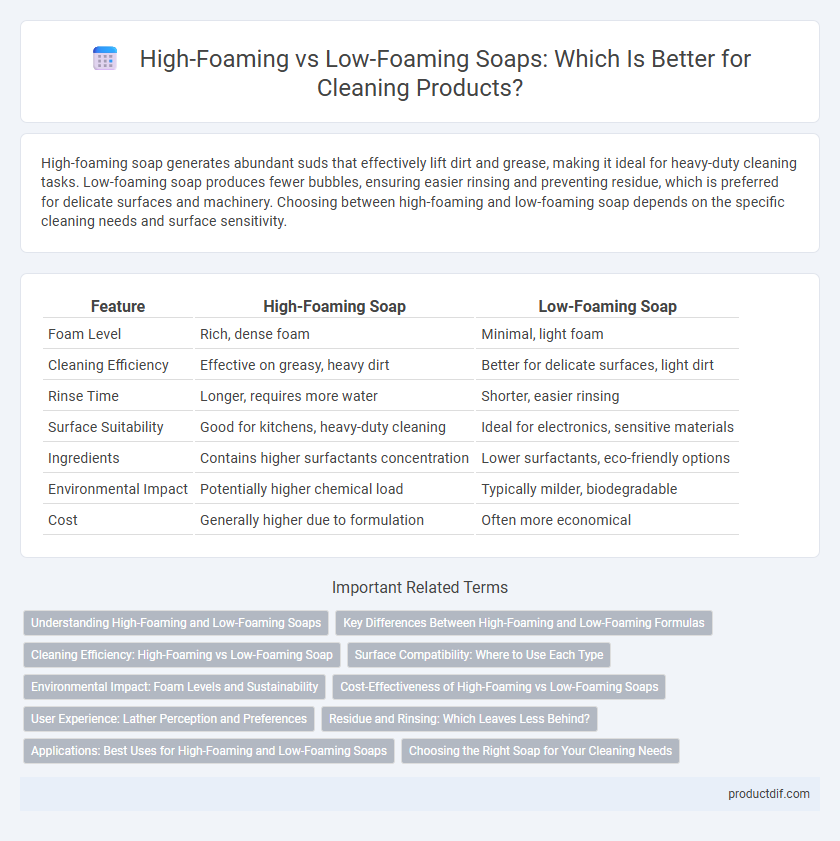High-foaming soap generates abundant suds that effectively lift dirt and grease, making it ideal for heavy-duty cleaning tasks. Low-foaming soap produces fewer bubbles, ensuring easier rinsing and preventing residue, which is preferred for delicate surfaces and machinery. Choosing between high-foaming and low-foaming soap depends on the specific cleaning needs and surface sensitivity.
Table of Comparison
| Feature | High-Foaming Soap | Low-Foaming Soap |
|---|---|---|
| Foam Level | Rich, dense foam | Minimal, light foam |
| Cleaning Efficiency | Effective on greasy, heavy dirt | Better for delicate surfaces, light dirt |
| Rinse Time | Longer, requires more water | Shorter, easier rinsing |
| Surface Suitability | Good for kitchens, heavy-duty cleaning | Ideal for electronics, sensitive materials |
| Ingredients | Contains higher surfactants concentration | Lower surfactants, eco-friendly options |
| Environmental Impact | Potentially higher chemical load | Typically milder, biodegradable |
| Cost | Generally higher due to formulation | Often more economical |
Understanding High-Foaming and Low-Foaming Soaps
High-foaming soaps create abundant bubbles and are effective in removing dirt and oils from skin and surfaces, making them ideal for tasks requiring thorough cleansing. Low-foaming soaps produce fewer bubbles, offering gentler cleaning suited for sensitive skin and delicate materials while minimizing residue. Understanding the formulation and application of high-foaming versus low-foaming soaps helps select the appropriate product for specific cleaning needs and preferences.
Key Differences Between High-Foaming and Low-Foaming Formulas
High-foaming soaps generate abundant bubbles that enhance cleaning by trapping dirt and grease effectively, making them ideal for heavy-duty cleaning tasks and oily surfaces. Low-foaming soaps produce fewer bubbles, which allows for easier rinsing and reduces residue, benefiting settings with sensitive equipment or hard water conditions. The choice between high-foaming and low-foaming formulas depends on the cleaning application, surface type, and rinsing requirements.
Cleaning Efficiency: High-Foaming vs Low-Foaming Soap
High-foaming soaps create dense lather that enhances dirt and grease suspension, improving cleaning efficiency on heavily soiled surfaces. Low-foaming soaps, often formulated for machine use or delicate materials, offer effective soil removal without excessive foam that can hinder rinsing. Choosing between high-foaming and low-foaming soap depends on the cleaning application, balancing foam generation with the need for thorough residue removal.
Surface Compatibility: Where to Use Each Type
High-foaming soap is ideal for non-porous surfaces such as countertops, glass, and tiles where thorough rinsing and residue removal are essential. Low-foaming soap suits delicate or porous surfaces like wood, leather, and fabrics, preventing moisture damage and residue buildup. Choosing the right foam level enhances cleaning efficiency and protects surface integrity during maintenance.
Environmental Impact: Foam Levels and Sustainability
High-foaming soaps often contain synthetic surfactants that can contribute to water pollution and hinder biodegradability, posing greater environmental risks compared to low-foaming soaps. Low-foaming soaps utilize biodegradable ingredients that reduce chemical runoff and improve water quality in natural ecosystems. Choosing low-foaming formulations supports sustainability by minimizing harmful residues and conserving aquatic life.
Cost-Effectiveness of High-Foaming vs Low-Foaming Soaps
High-foaming soaps typically require less product per use due to their rich lather, leading to cost savings over time despite a higher initial price. Low-foaming soaps often demand larger quantities to achieve effective cleaning, increasing overall consumption and expense. Evaluating the balance between product usage and purchase frequency reveals high-foaming soaps as a more cost-effective option for prolonged cleaning tasks.
User Experience: Lather Perception and Preferences
High-foaming soaps create a rich, creamy lather that many users associate with superior cleanliness and sensory satisfaction, enhancing the overall washing experience. Low-foaming soaps tend to be preferred for sensitive skin as they reduce residue and irritation, offering a gentler feel without compromising efficacy. User preferences often hinge on the balance between lather volume and skin comfort, influencing product choice in personal hygiene routines.
Residue and Rinsing: Which Leaves Less Behind?
High-foaming soaps often contain surfactants that create abundant foam but can leave behind more residue, requiring thorough rinsing to prevent buildup on surfaces. Low-foaming soaps typically have fewer additives and rinse away more easily, minimizing residue and reducing the time needed for rinsing. Selecting low-foaming soap enhances cleaning efficiency by ensuring less residue remains and simplifying the rinsing process.
Applications: Best Uses for High-Foaming and Low-Foaming Soaps
High-foaming soaps are ideal for removing heavy dirt and grease in industrial kitchens and automotive cleaning, where strong lather helps lift stubborn residues. Low-foaming soaps are preferred in delicate cleaning tasks such as handwashing dishes and cleaning sensitive electronic screens, minimizing residue and avoiding damage. Selecting the appropriate foam level enhances cleaning efficiency and protects surfaces based on specific application needs.
Choosing the Right Soap for Your Cleaning Needs
High-foaming soaps generate abundant lather, making them ideal for cleaning heavily soiled surfaces and greasy residues by effectively trapping and lifting dirt. Low-foaming soaps are preferred for delicate surfaces and equipment, reducing residue and minimizing damage while still providing cleaning power. Selecting the right soap depends on the type of surface, level of dirt, and specific cleaning requirements to ensure effective and safe cleaning results.
High-foaming soap vs low-foaming soap Infographic

 productdif.com
productdif.com